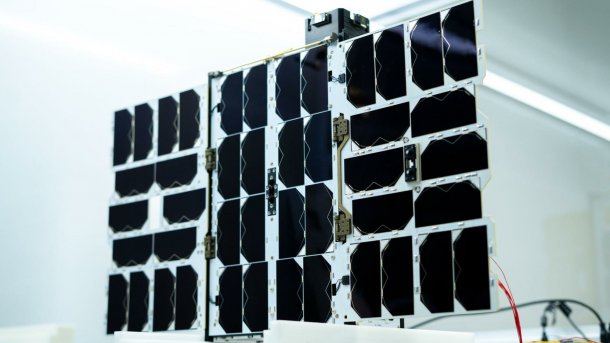Missing Link: India's Space Babies — The Ultrasound of a Huge Future
India has sent a craft to the moon. But there’s more happening about space, spilling over into new answers in communication, data apps, sat-imagery, and more.

Camera-constellation for Pixxel's TD-2 satellite
(Bild: Pixxel)
Note: Eine deutsche Variante dieses Artikel ist ebenfalls verfügbar.
A dingy, dusty, and drab room changed into a make-shift lab. This is where those two boys meet for the first time. The ones who started it all. As shown in a hit series Rocket Boys about India's Space explorers Homi J Bhaba and Vikram A Sarabhai, this is where India's ambitious, encounter with Space science began. Both were young, experimentative and passionate-about-science boys, who shook hands for the first time as Bhaba (1909-1966) interviewed Sarabhai (1919-1971) for a research project. Their minds instantly clicked.
They did a lot of path-breaking work together. They were sort of soul-mates when it comes to the spirit of enquiry and unrelenting rigour for research. Yet, on many subject, they never saw eye to eye. Like the 'Final Parsec problem', they always stood 'just a few light years' apart in their perspectives on how to use nuclear science and physics. One fought for India's energy independence and the other pursued the less-trodden pavement of solving problems of the 'everyday Indian'. But they stood friends till the end. Today, if they were to visit any other small lab in India – they might change their minds and shake hands again. Here's why.
Making space for 'Space'
Not that dusty. Not that dingy. But there are many rooms in India right now where innovators are happily-busy with heads buried into new ideas, prototypes and pilots for, and beyond, space exploration. At the Institutes of Eminence research centre on Extra Terrestrial Manufacturing (ExTeM), researchers are working on developing technologies for manufacturing in space, from hybrid-3D printing metals to synthesizing crystals and biologicals.
Sathyan Subbiah, professor at the ExTeM Research Group at the Indian Institute of Technology Madras, lets on how several tests are conducted in the micro-gravity drop tower on his campus. "We are having discussions for new start-ups that offer microgravity platform services such as parabolic flights; we are also working with start-ups such as Vellon Space planning tests in orbit."
Then there is rocket-engineer-turned-space-entrepreneur Pawan Chandana who came together with experts in solid propulsion and cryogenic rocket technology to launch Skyroot Aerospace. That venture is set for designing and building space launch vehicles in the Indian private space sector. It is already celebrating many count-downs and has recently completed a full-duration test of the third stage of its Vikram-I launch vehicle.
Not far away, in Hyderabad, students make products for agriculture drones using autonomous flight technology and programmable controllers put together with GPS. Students at Gandhi Institute of Technology and Management Deemed University have already taken off the ground with a venture named Mydhili Aerospace. There is also the Agnikul rocket, incubated in a university in Madras, which is working on making highly-customisable two-stage launch vehicles – ready with access to over ten launch-pads and 25 more on the way. This start-up is promising a Launch-When-You-Want capability where payload integration to launch won’t take more than two weeks.
Efficiency Writ Large
From new-age space cartographers like Digantara to hyperspectral earth imaging satellites for space data like Pixxel, many ventures and explorers are eyeing the once-elusive frontiers of space. Pixxel's low-orbit imaging satellite was carried by SpaceX in 2022. More satellites from Pixxel will be sent this year, giving it a daily global coverage by early 2024. Similarly, KaleidEO is aiming for aerial testing of its high-resolution high-swath optical and multi-spectral sensors very soon, leading to manufacturing of the satellites and their sensors.
These launches could not have been better-timed. Grand View Research estimates that the global space technology market can reach 732 billion US-Dollars by 2030, driven by demand for satellite-based services like telecommunications, broadcasting, weather forecasting, and remote sensing. More so, as smaller satellites pack enhanced manoeuvrability, cost-effectiveness, and rapid deployment options – just the thing that specific applications want.
The global satellite internet market size can hit 18.6 billion dollars by 2030, according to an estimate by Allied Market Reserach. This is a perfect trajectory for India's space edge and age – specially after the splendid success of recent lunar and solar missions. John Strand, CEO of Strand Consult, notes how the satellite industry has gone through a revolution where the cost of launching satellites has plummeted. "The price of heavy launches to low earth orbit has fallen from 65,000 dollars per kilogram to 1,500 dollars per kilogram", Strand notes.
(Bild: IIT Madras)
Ask Pradeep Gupta, a former member of India's government and the founder of the think-tank Security and Policy Initiatives; he will tell you how private participation in Indian space forays is worth emulating by other sectors. Especially, as the country has set up the Indian National Space Promotion and Authorisation Centre (IN-SPACe) to facilitate cooperation with private industries. been set up.
Yerramreddy Nivesh Reddy, founder and CEO of Mydhili Aero Space says, "Beyond commercial space travel, we foresee applications in areas like software defined networking (SDN) and edge data centres, which can revolutionise communication and data processing." Another way to confirm this pattern is by looking at the venture capital space. Smita Pawar of the venture capital investor Hyderabad Angels avers that there is a lot of innovation happening in this space. "Many start-ups (from payloads to emerging space-tech) are emerging. They are at a nascent stage, but will soon catch the eyes of investors as they take-off further." Pawan Chandana, co-founder and CEO of Skyroot Aerospace, adds: "India's recent achievements should bolster global investor confidence in India's burgeoning space industry, including the private sector, thus attracting more global joint ventures, investment, collaboration and partnerships."